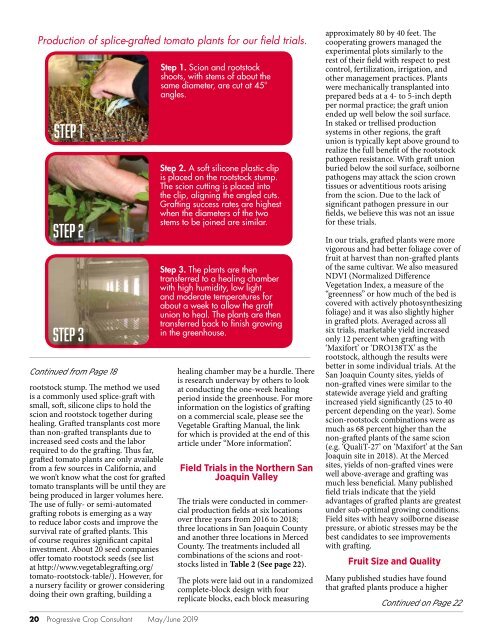PCC_MayJun_2019_e
You also want an ePaper? Increase the reach of your titles
YUMPU automatically turns print PDFs into web optimized ePapers that Google loves.
Production of splice-grafted tomato plants for our field trials.<br />
Step 1<br />
Step 2<br />
Step 3<br />
Continued from Page 18<br />
rootstock stump. The method we used<br />
is a commonly used splice-graft with<br />
small, soft, silicone clips to hold the<br />
scion and rootstock together during<br />
healing. Grafted transplants cost more<br />
than non-grafted transplants due to<br />
increased seed costs and the labor<br />
required to do the grafting. Thus far,<br />
grafted tomato plants are only available<br />
from a few sources in California, and<br />
we won’t know what the cost for grafted<br />
tomato transplants will be until they are<br />
being produced in larger volumes here.<br />
The use of fully- or semi-automated<br />
grafting robots is emerging as a way<br />
to reduce labor costs and improve the<br />
survival rate of grafted plants. This<br />
of course requires significant capital<br />
investment. About 20 seed companies<br />
offer tomato rootstock seeds (see list<br />
at http://www.vegetablegrafting.org/<br />
tomato-rootstock-table/). However, for<br />
a nursery facility or grower considering<br />
doing their own grafting, building a<br />
Step 1. Scion and rootstock<br />
shoots, with stems of about the<br />
same diameter, are cut at 45°<br />
angles.<br />
Step 2. A soft silicone plastic clip<br />
is placed on the rootstock stump.<br />
The scion cutting is placed into<br />
the clip, aligning the angled cuts.<br />
Grafting success rates are highest<br />
when the diameters of the two<br />
stems to be joined are similar.<br />
Step 3. The plants are then<br />
transferred to a healing chamber<br />
with high humidity, low light<br />
and moderate temperatures for<br />
about a week to allow the graft<br />
union to heal. The plants are then<br />
transferred back to finish growing<br />
in the greenhouse.<br />
healing chamber may be a hurdle. There<br />
is research underway by others to look<br />
at conducting the one-week healing<br />
period inside the greenhouse. For more<br />
information on the logistics of grafting<br />
on a commercial scale, please see the<br />
Vegetable Grafting Manual, the link<br />
for which is provided at the end of this<br />
article under “More information”.<br />
Field Trials in the Northern San<br />
Joaquin Valley<br />
The trials were conducted in commercial<br />
production fields at six locations<br />
over three years from 2016 to 2018;<br />
three locations in San Joaquin County<br />
and another three locations in Merced<br />
County. The treatments included all<br />
combinations of the scions and rootstocks<br />
listed in Table 2 (See page 22).<br />
The plots were laid out in a randomized<br />
complete-block design with four<br />
replicate blocks, each block measuring<br />
approximately 80 by 40 feet. The<br />
cooperating growers managed the<br />
experimental plots similarly to the<br />
rest of their field with respect to pest<br />
control, fertilization, irrigation, and<br />
other management practices. Plants<br />
were mechanically transplanted into<br />
prepared beds at a 4- to 5-inch depth<br />
per normal practice; the graft union<br />
ended up well below the soil surface.<br />
In staked or trellised production<br />
systems in other regions, the graft<br />
union is typically kept above ground to<br />
realize the full benefit of the rootstock<br />
pathogen resistance. With graft union<br />
buried below the soil surface, soilborne<br />
pathogens may attack the scion crown<br />
tissues or adventitious roots arising<br />
from the scion. Due to the lack of<br />
significant pathogen pressure in our<br />
fields, we believe this was not an issue<br />
for these trials.<br />
In our trials, grafted plants were more<br />
vigorous and had better foliage cover of<br />
fruit at harvest than non-grafted plants<br />
of the same cultivar. We also measured<br />
NDVI (Normalized Difference<br />
Vegetation Index, a measure of the<br />
“greenness” or how much of the bed is<br />
covered with actively photosynthesizing<br />
foliage) and it was also slightly higher<br />
in grafted plots. Averaged across all<br />
six trials, marketable yield increased<br />
only 12 percent when grafting with<br />
‘Maxifort’ or ‘DRO138TX’ as the<br />
rootstock, although the results were<br />
better in some individual trials. At the<br />
San Joaquin County sites, yields of<br />
non-grafted vines were similar to the<br />
statewide average yield and grafting<br />
increased yield significantly (25 to 40<br />
percent depending on the year). Some<br />
scion-rootstock combinations were as<br />
much as 68 percent higher than the<br />
non-grafted plants of the same scion<br />
(e.g. ‘QualiT-27’ on ‘Maxifort’ at the San<br />
Joaquin site in 2018). At the Merced<br />
sites, yields of non-grafted vines were<br />
well above-average and grafting was<br />
much less beneficial. Many published<br />
field trials indicate that the yield<br />
advantages of grafted plants are greatest<br />
under sub-optimal growing conditions.<br />
Field sites with heavy soilborne disease<br />
pressure, or abiotic stresses may be the<br />
best candidates to see improvements<br />
with grafting.<br />
Fruit Size and Quality<br />
Many published studies have found<br />
that grafted plants produce a higher<br />
Continued on Page 22<br />
20 Progressive Crop Consultant May/June <strong>2019</strong>


















